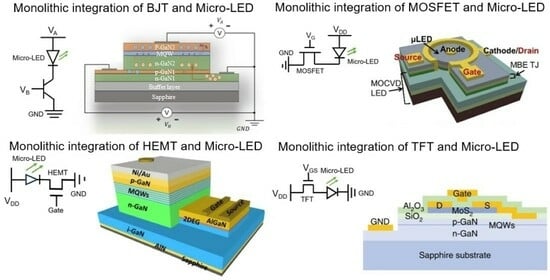Monolithic Integration of GaN-Based Transistors and Micro-LED
Abstract
:1. Introduction
1.1. Emerging of Micro-LED Display Technology
1.2. Nanostructure for GaN-Based Micro-LED
1.3. Major Challenges in Micro-LED Integration Process
2. Innovation and Development of On-Chip Integration Technology
2.1. BJT-Integrated Micro-LED
2.2. MOSFET-Integrated Micro-LED
2.3. HEMT-Integrated Micro-LED
2.4. TFT-Integrated Micro-LED
3. Conclusions
Author Contributions
Funding
Data Availability Statement
Acknowledgments
Conflicts of Interest
References
- Weston, G.F. Plasma panel displays. J. Phys. E Sci. Instrum. 1975, 8, 981. [Google Scholar] [CrossRef] [PubMed]
- Boeuf, J.P. Plasma display panels: Physics, recent developments and key issues. J. Phys. D Appl. Phys. 2003, 36, R53. [Google Scholar] [CrossRef]
- Kawamoto, H. The history of liquid-crystal displays. Proc. IEEE 2002, 90, 460–500. [Google Scholar] [CrossRef]
- Geffroy, B.; Le Roy, P.; Prat, C. Organic light-emitting diode (OLED) technology: Materials, devices and display technologies. Polym. Int. 2006, 55, 572–582. [Google Scholar] [CrossRef]
- Jiang, H.X.; Lin, J.Y. Nitride micro-LEDs and beyond-a decade progress review. Opt. Express 2013, 21, A475–A484. [Google Scholar] [CrossRef]
- Wu, T.; Sher, C.-W.; Lin, Y.; Lee, C.-F.; Liang, S.; Lu, Y.; Chen, S.-W.H.; Guo, W.; Kuo, H.-C.; Chen, Z. Mini-LED and micro-LED: Promising candidates for the next generation display technology. Appl. Sci. 2018, 8, 1557. [Google Scholar] [CrossRef]
- Wong, M.S.; Nakamura, S.; DenBaars, S.P. progress in high performance III-nitride micro-light-emitting diodes. ECS J. Solid State Sci. Technol. 2020, 9, 015012. [Google Scholar] [CrossRef]
- Huang, Y.; Hsiang, E.-L.; Deng, M.-Y.; Wu, S.-T. Mini-LED, Micro-LED and OLED displays: Present status and future perspectives. Light Sci. Appl. 2020, 9, 105. [Google Scholar] [CrossRef] [PubMed]
- Lin, C.C.; Wu, Y.R.; Kuo, H.C.; Wong, M.S.; DenBaars, S.P.; Nakamura, S.; Pandey, A.; Mi, Z.; Tian, P.; Ohkawa, K.; et al. The micro-LED roadmap: Status quo and prospects. J. Phys. Photonics 2023, 5, 042502. [Google Scholar] [CrossRef]
- Zhuang, Z.; Iida, D.; Ohkawa, K. InGaN-based red light-emitting diodes: From traditional to micro-LEDs. Jpn. J. Appl. Phys. 2021, 61, SA0809. [Google Scholar] [CrossRef]
- Zhao, C.; Ng, T.K.; ElAfandy, R.T.; Prabaswara, A.; Consiglio, G.B.; Ajia, I.A.; Roqan, I.S.; Janjua, B.; Shen, C.; Eid, J.; et al. Droop-free, reliable, and high-power InGaN/GaN nanowire light-emitting diodes for monolithic metal-optoelectronics. Nano Lett. 2016, 16, 4616–4623. [Google Scholar] [CrossRef]
- Liu, X.; Sun, Y.; Malhotra, Y.; Pandey, A.; Wang, P.; Wu, Y.; Sun, K.; Mi, Z. N-polar InGaN nanowires: Breaking the efficiency bottleneck of nano and micro LEDs. Photonics Res. 2022, 10, 587–593. [Google Scholar] [CrossRef]
- Pandey, A.; Malhotra, Y.; Wang, P.; Sun, K.; Liu, X.; Mi, Z. N-polar InGaN/GaN nanowires: Overcoming the efficiency cliff of red-emitting micro-LEDs. Photonics Res. 2022, 10, 1107–1116. [Google Scholar] [CrossRef]
- Ra, Y.H.; Rashid, R.T.; Liu, X.; Lee, J.; Mi, Z. Scalable nanowire photonic crystals: Molding the light emission of InGaN. Adv. Funct. Mater. 2017, 27, 1702364. [Google Scholar] [CrossRef]
- Ra, Y.H.; Wang, R.; Woo, S.Y.; Djavid, M.; Sadaf, S.M.; Lee, J.; Botton, G.A.; Mi, Z. Full-color single nanowire pixels for projection displays. Nano Lett. 2016, 16, 4608–4615. [Google Scholar] [CrossRef]
- Zhou, X.; Tian, P.; Sher, C.-W.; Wu, J.; Liu, H.; Liu, R.; Kuo, H.-C. Growth, transfer printing and colour conversion techniques towards full-colour micro-LED display. Prog. Quantum Electron. 2020, 71, 100263. [Google Scholar] [CrossRef]
- Wu, Y.; Ma, J.; Su, P.; Zhang, L.; Xia, B. Full-color realization of micro-LED displays. Nanomaterials 2020, 10, 2482. [Google Scholar] [CrossRef]
- Zhuang, Z.; Iida, D.; Ohkawa, K. Ultrasmall and ultradense InGaN-based RGB monochromatic micro-light-emitting diode arrays by pixilation of conductive p-GaN. Photonics Res. 2021, 9, 2429–2434. [Google Scholar] [CrossRef]
- Liu, Z.; Lin, C.H.; Hyun, B.R.; Sher, C.W.; Lv, Z.; Luo, B.; Jiang, F.; Wu, T.; Ho, C.H.; Kuo, H.C.; et al. Micro-light-emitting diodes with quantum dots in display technology. Light Sci. Appl. 2020, 9, 83. [Google Scholar] [CrossRef] [PubMed]
- Yin, Y.; Hu, Z.; Ali, M.U.; Duan, M.; Gao, L.; Liu, M.; Peng, W.; Geng, J.; Pan, S.; Wu, Y.; et al. Full-color micro-LED display with CsPbBr3 perovskite and CdSe quantum dots as color conversion layers. Adv. Mater. Technol. 2020, 5, 2000251. [Google Scholar] [CrossRef]
- Ryu, J.E.; Park, S.; Park, Y.; Ryu, S.W.; Hwang, K.; Jang, H.W. Technological Breakthroughs in Chip Fabrication, Transfer, and Color Conversion for High-Performance Micro-LED Displays. Adv. Mater. 2023, 35, 2204947. [Google Scholar] [CrossRef]
- Fan, X.; Wu, T.; Liu, B.; Zhang, R.; Kuo, H.-C.; Chen, Z. Recent developments of quantum dot based micro-LED based on non-radiative energy transfer mechanism. Opto-Electron. Adv. 2021, 4, 210022-1–210022-15. [Google Scholar] [CrossRef]
- Chen, F.; Bian, J.; Hu, J.; Sun, N.; Yang, B.; Ling, H.; Yu, H.; Wang, K.; Gai, M.; Ma, Y.; et al. Mass transfer techniques for large-scale and high-density microLED arrays. Int. J. Extrem. Manuf. 2022, 4, 042005. [Google Scholar] [CrossRef]
- Niu, P.; Sun, H.; Zhaofeng, L.; Qiang, L.; Shinan, C.; Haitao, T. Design and force analysis of the chip transfer platform for mass transfer. In Proceedings of the 2021 18th China International Forum on Solid State Lighting & 2021 7th International Forum on Wide Bandgap Semiconductors (SSLChina: IFWS), Jiangsu, China, 6–8 December 2021; IEEE: New York, NY, USA, 2021; pp. 143–145. [Google Scholar]
- Lin, Y.Z.; Liu, C.; Zhang, J.H.; Yuan, Y.K.; Cai, W.; Zhou, L.; Xu, M.; Wang, L.; Wu, W.J.; Peng, J.B. Active-matrix micro-LED display driven by metal oxide TFTs using digital PWM method. IEEE Trans. Electron Devices 2021, 68, 5656–5661. [Google Scholar] [CrossRef]
- Gao, H.; Zou, M.; Zhong, C.; Zhuang, J.; Lin, J.; Lu, Z.; Jiang, Z.; Lu, Y.; Chen, Z.; Guo, W. Advances in pixel driving technology for micro-LED displays. Nanoscale 2023, 15, 17232–17248. [Google Scholar] [CrossRef] [PubMed]
- Chung, J.-M.; Zhang, X.; Shang, F.; Kim, J.-H.; Wang, X.-L.; Liu, S.; Yang, B.; Xiang, Y. Enhancement of a-IGZO TFT device performance using a clean interface process via etch-stopper nano-layers. Nanoscale Res. Lett. 2018, 13, 164. [Google Scholar] [CrossRef] [PubMed]
- Choi, I.M.; Kim, M.J.; On, N.; Song, A.; Chung, K.B.; Jeong, H.; Park, J.K.; Jeong, J.K. Achieving high mobility and excellent stability in amorphous In–Ga–Zn–Sn–O thin-film transistors. IEEE Trans. Electron Devices 2020, 67, 1014–1020. [Google Scholar] [CrossRef]
- Zhu, Y.; He, Y.; Jiang, S.; Zhu, L.; Chen, C.; Wan, Q. Indium–gallium–zinc–oxide thin-film transistors: Materials, devices, and applications. J. Semicond. 2021, 42, 031101. [Google Scholar] [CrossRef]
- Rae, B.R.; Griffin, C.; McKendry, J.; Girkin, J.M.; Zhang, H.X.; Gu, E.; Renshaw, D.; Charbon, E.; Dawson, M.D.; Henderson, R.K. CMOS driven micro-pixel LEDs integrated with single photon avalanche diodes for time resolved fluorescence measurements. J. Phys. D Appl. Phys. 2008, 41, 094011. [Google Scholar] [CrossRef]
- Zhang, X.; Yin, L.; Ren, K.; Zhang, J. Research on Simulation Design of MOS Driver for Micro-LED. Electronics 2022, 11, 2044. [Google Scholar] [CrossRef]
- Seong, J.; Jang, J.; Lee, J.; Lee, M. CMOS backplane pixel circuit with leakage and voltage drop compensation for an micro-LED display achieving 5000 PPI or higher. IEEE Access 2020, 8, 49467–49476. [Google Scholar] [CrossRef]
- Tsuchiyama, K.; Yamane, K.; Utsunomiya, S.; Sekiguchi, H.; Okada, H.; Wakahara, A. Monolithic integration of Si-MOSFET and GaN-LED using Si/SiO2/GaN-LED wafer. Appl. Phys. Express 2016, 9, 104101. [Google Scholar] [CrossRef]
- Liu, C.; Cai, Y.; Zou, X.; Lau, K.M. Low-leakage high-breakdown laterally integrated HEMT-LED via n-GaN electrode. IEEE Photonics Technol. Lett. 2016, 28, 1130–1133. [Google Scholar] [CrossRef]
- Aoqi, F.; Weiling, G.; Hao, X.; Jixin, L. Research on monolithic integrated driver of Micro LED. In Proceedings of the 2022 19th China International Forum on Solid State Lighting & 2022 8th International Forum on Wide Bandgap Semiconductors (SSLCHINA: IFWS), Suzhou, China, 7–10 February 2023; IEEE: New York, NY, USA, 2023; pp. 296–302. [Google Scholar]
- Chen, D.; Chen, Y.C.; Zeng, G.; Zhang, D.W.; Lu, H.L. Integration Technology of Micro-LED for Next-Generation Display. Research 2023, 6, 47. [Google Scholar] [CrossRef]
- Hao, S.; Ye, J.; Guo, C.; Zhou, X.; Zhang, Y.; Wu, C.; Guo, T.; Sun, J.; Yan, Q.; Zhan, F.; et al. Fully GaN Monolithic Integrated Light Emitting Triode-on-Bipolar Junction Transistor Device Drivable with Small Current Signals and Its Frequency Response Characteristic: A Modeling and Simulation Study. Phys. Status Solidi A 2022, 219, 2200606. [Google Scholar] [CrossRef]
- Fu, W.Y.; Choi, H.W. GaN PNP light-emitting bipolar junction transistor. J. Phys. D Appl. Phys. 2021, 55, 015101. [Google Scholar] [CrossRef]
- Su, W.; Wang, H.; Zou, Z.; Chai, C.; Weng, S.; Ye, J.; Sun, J.; Yan, Q.; Zhou, X.; Wu, C.; et al. Design and Photomodulation Performance of a UV-Driven Full GaN Integrated μLED and BJT Phototransistor. ACS Photonics 2024, 11, 649–659. [Google Scholar] [CrossRef]
- Lee, Y.J.; Yang, Z.P.; Chen, P.G.; Hsieh, Y.A.; Yao, Y.C.; Liao, M.H.; Lee, M.H.; Wang, M.T.; Hwang, J.M. Monolithic integration of GaN-based light-emitting diodes and metal-oxide-semiconductor field-effect transistors. Opt. Express 2014, 22, A1589–A1595. [Google Scholar] [CrossRef]
- Lu, X.; Liu, C.; Jiang, H.; Zou, X.; Lau, K.M. High performance monolithically integrated GaN driving VMOSFET on LED. IEEE Electron Device Lett. 2017, 38, 752–755. [Google Scholar] [CrossRef]
- Sang, Y.; Zhang, D.; Zhuang, Z.; Yu, J.; Xu, F.; Jiang, D.; Wang, K.; Tao, T.; Wang, X.; Zhang, R.; et al. Monolithic integration of GaN-based green micro-LED and quasi-vertical MOSFET utilizing a hybrid tunnel junction. IEEE Electron Device Lett. 2023, 44, 1156–1159. [Google Scholar] [CrossRef]
- Liu, Y.; Liu, Z.; Lau, K.M. Monolithic integrated all-GaN-based µLED display by selective area regrowth. Opt. Express 2023, 31, 31300–31307. [Google Scholar] [CrossRef]
- Liu, Z.J.; Huang, T.; Ma, J.; Liu, C.; Lau, K.M. Monolithic integration of AlGaN/GaN HEMT on LED by MOCVD. IEEE Electron Device Lett. 2014, 35, 330–332. [Google Scholar] [CrossRef]
- Cai, Y.; Gong, Y.; Bai, J.; Yu, X.; Zhu, C.; Esendag, V.; Lee, K.B.; Wang, T. Controllable uniform green light emitters enabled by circular HEMT-LED devices. IEEE Photonics J. 2018, 10, 1–7. [Google Scholar] [CrossRef]
- Chen, D.; Liu, Z.; Lu, X.; Wan, L.; Li, R.; Yang, Z.; Li, G. Efficiency improved by monolithic integration of HEMT with vertical-structure LEDs and Mg doping on dry etched GaN. J. Mater. Chem. C 2019, 7, 2823–2828. [Google Scholar] [CrossRef]
- Meng, W.; Xu, F.; Yu, Z.; Tao, T.; Shao, L.; Liu, L.; Li, T.; Wen, K.; Wang, J.; He, L.; et al. Three-dimensional monolithic micro-LED display driven by atomically thin transistor matrix. Nat. Nanotechnol. 2021, 16, 1231–1236. [Google Scholar] [CrossRef]
- Hwangbo, S.; Hu, L.; Hoang, A.T.; Choi, J.Y.; Ahn, J.-H. Wafer-scale monolithic integration of full-colour micro-LED display using MoS2 transistor. Nat. Nanotechnol. 2022, 17, 500–506. [Google Scholar] [CrossRef]
- Hartensveld, M.; Zhang, J. Monolithic integration of GaN nanowire light-emitting diode with field effect transistor. IEEE Electron Device Lett. 2019, 40, 427–430. [Google Scholar] [CrossRef]
- Wierer, J.J., Jr.; Tansu, N. III-Nitride micro-LEDs for efficient emissive displays. Laser Photonics Rev. 2019, 13, 1900141. [Google Scholar] [CrossRef]
- Chen, Z.; Yan, S.; Danesh, C. MicroLED technologies and applications: Characteristics, fabrication, progress, and challenges. J. Phys. D Appl. Phys. 2021, 54, 123001. [Google Scholar] [CrossRef]
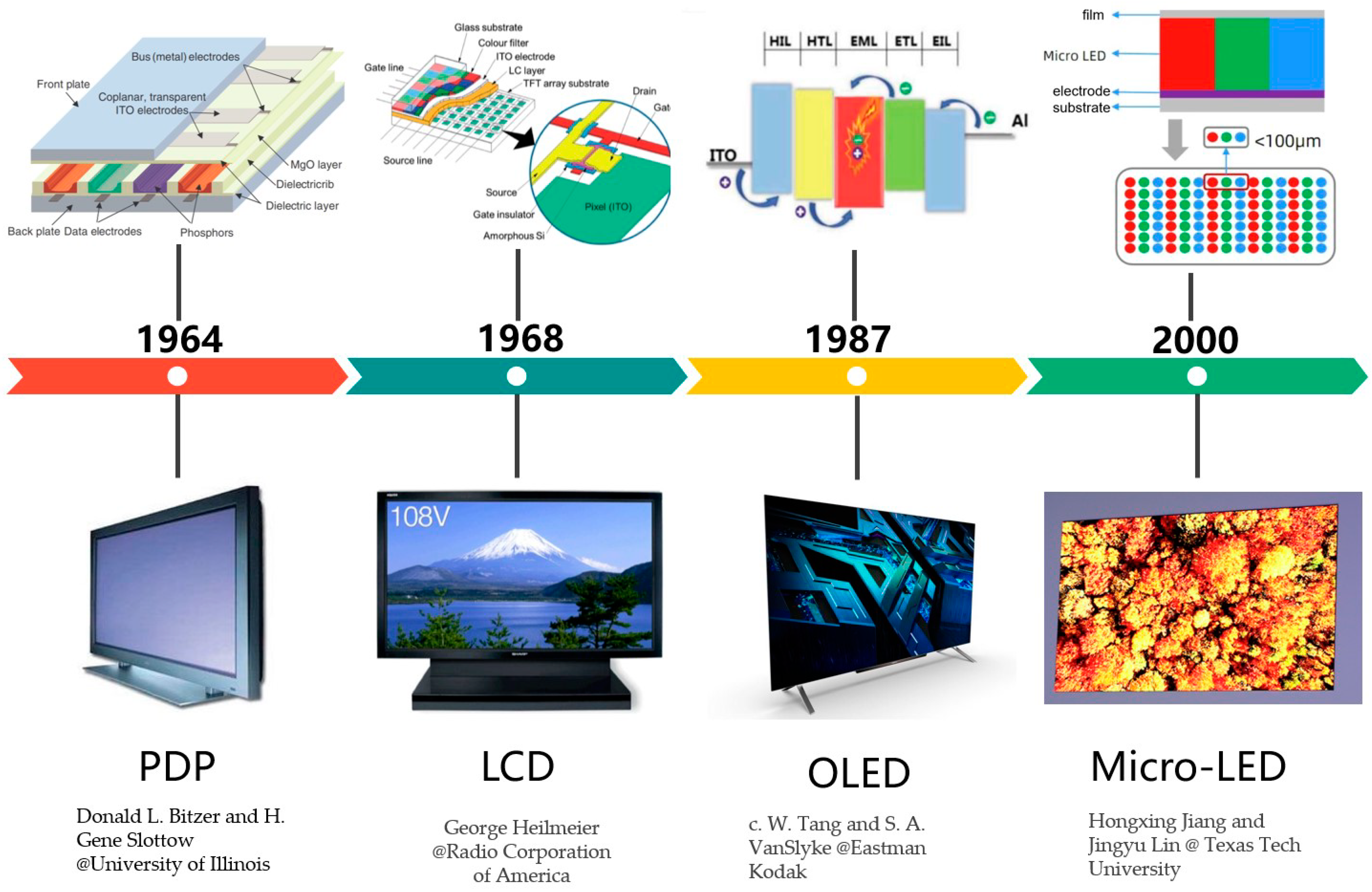
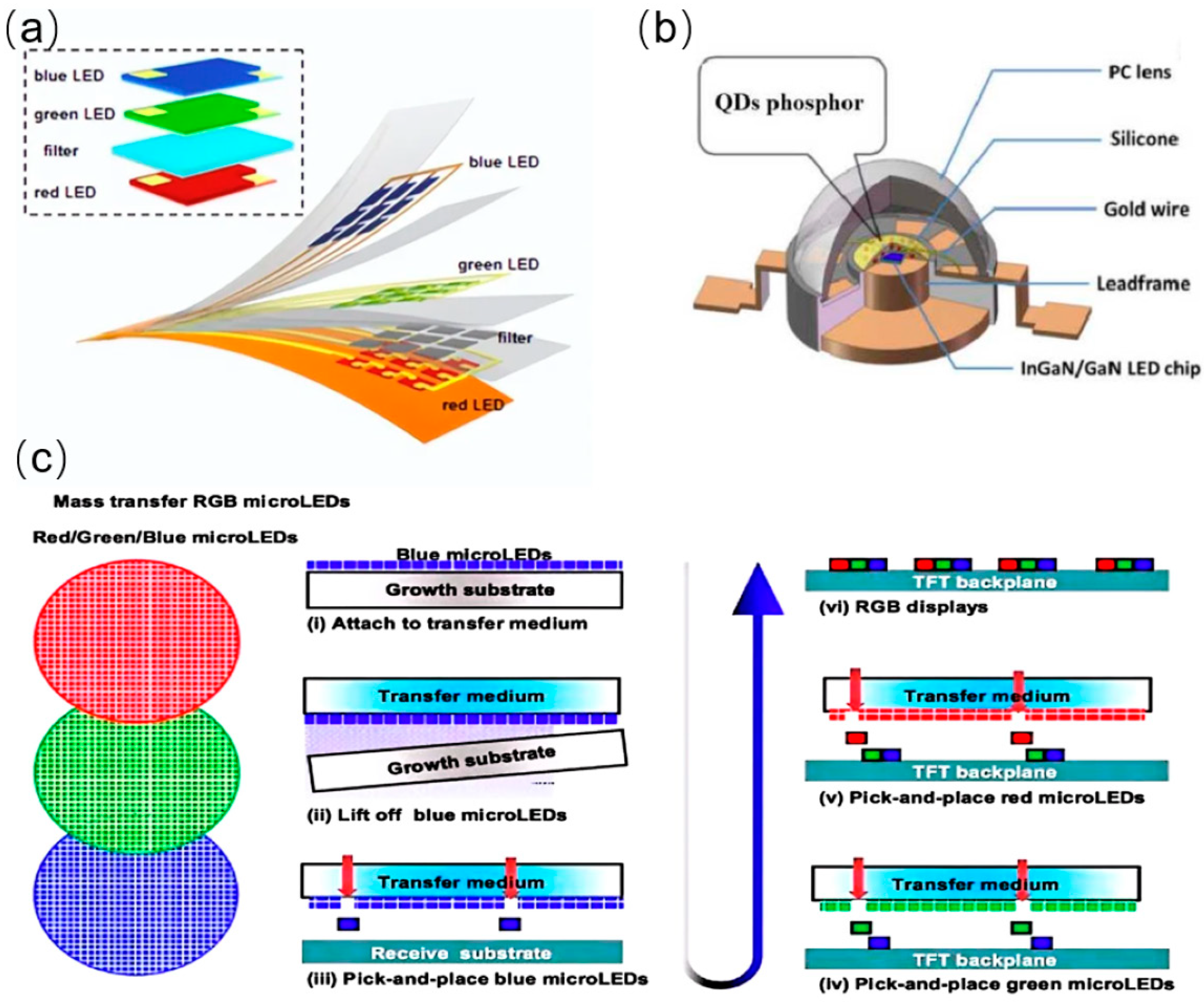



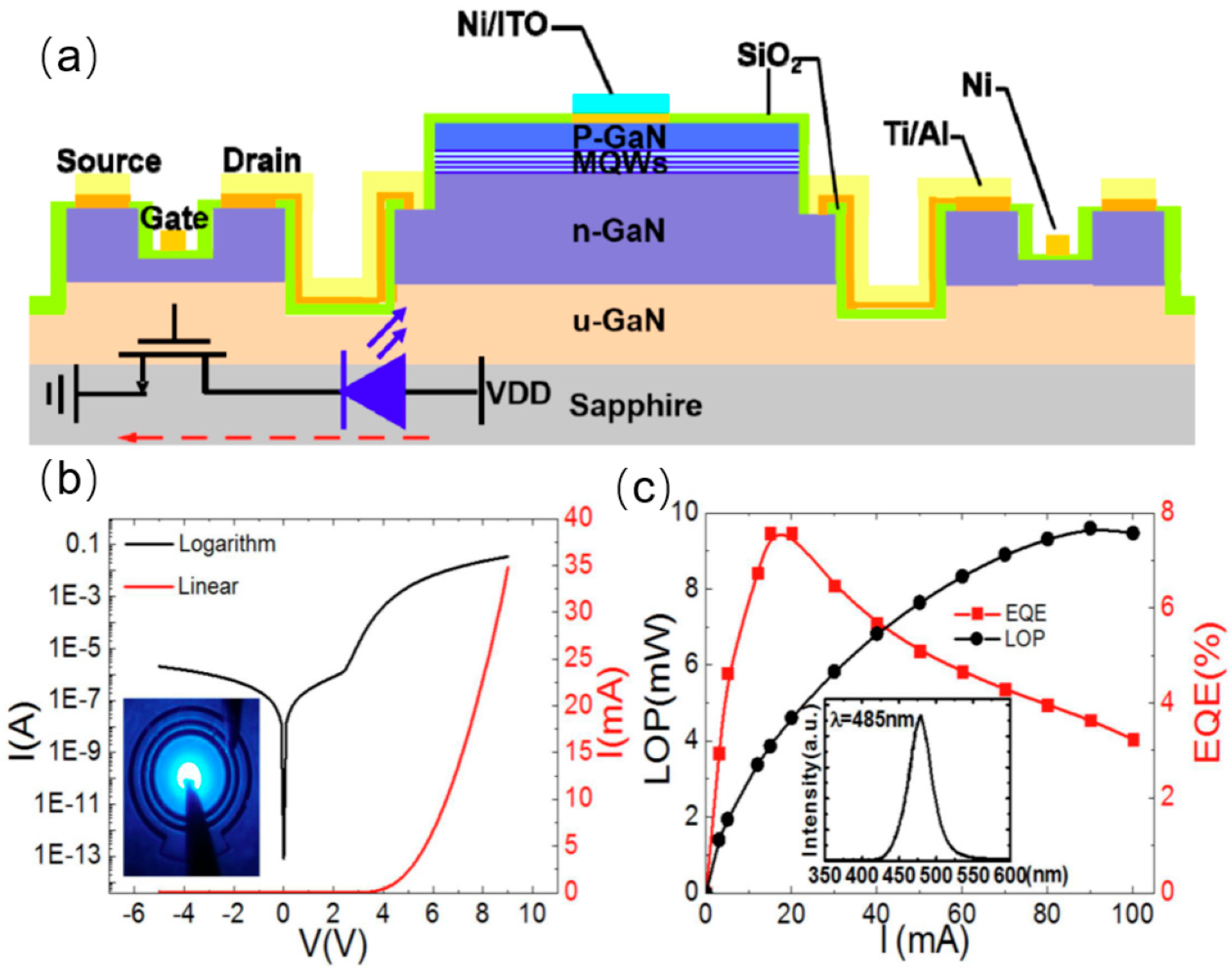
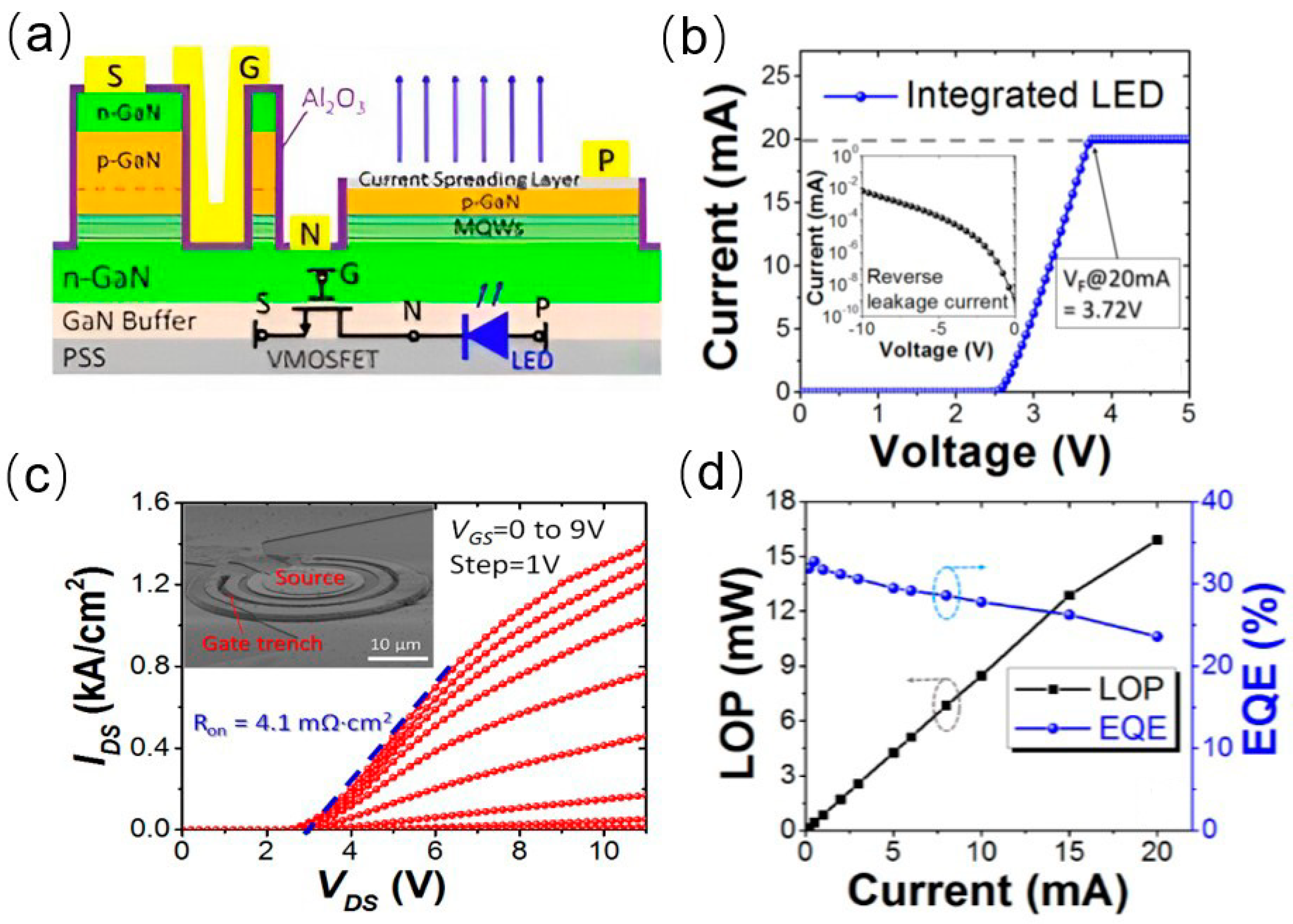
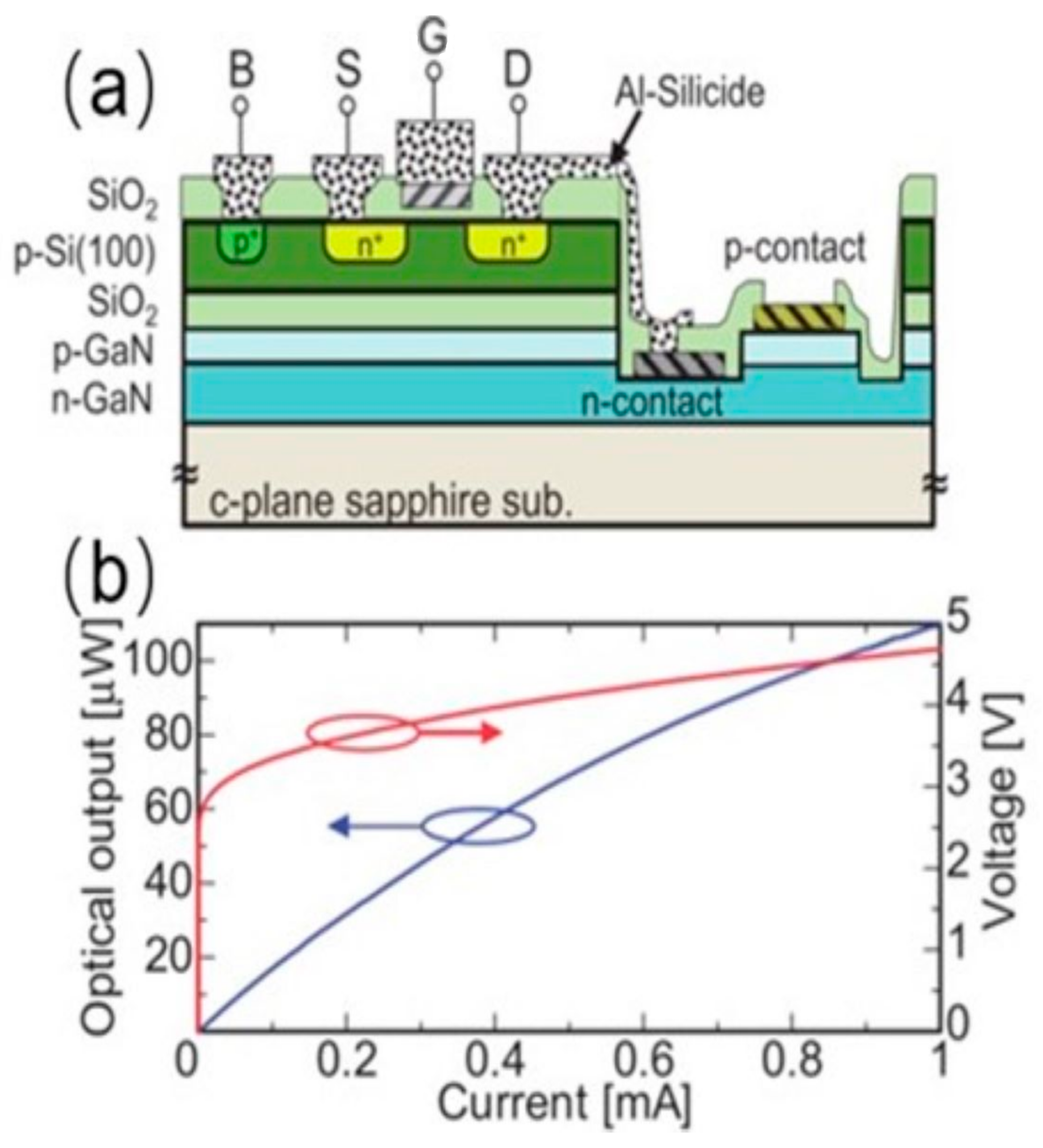

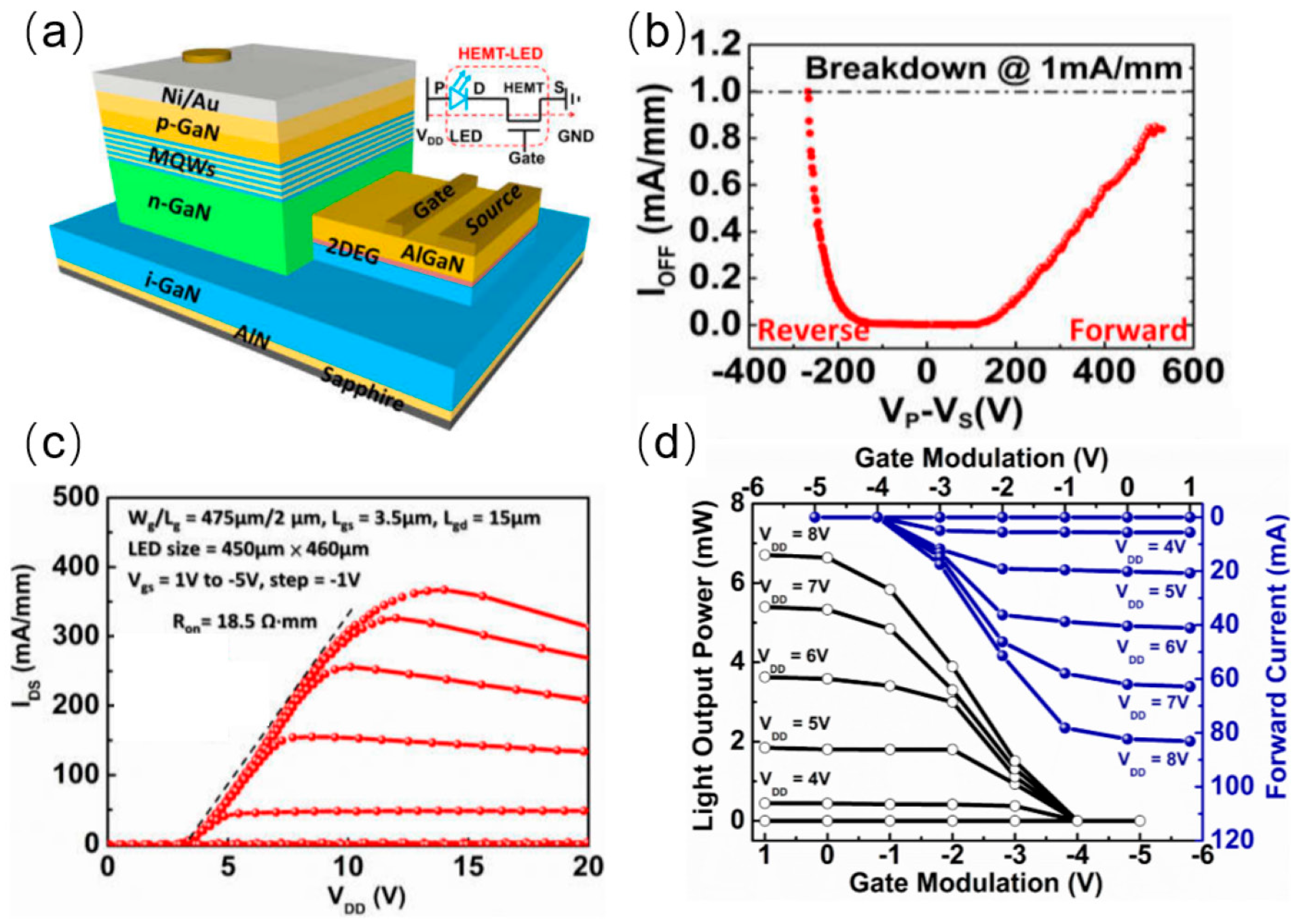
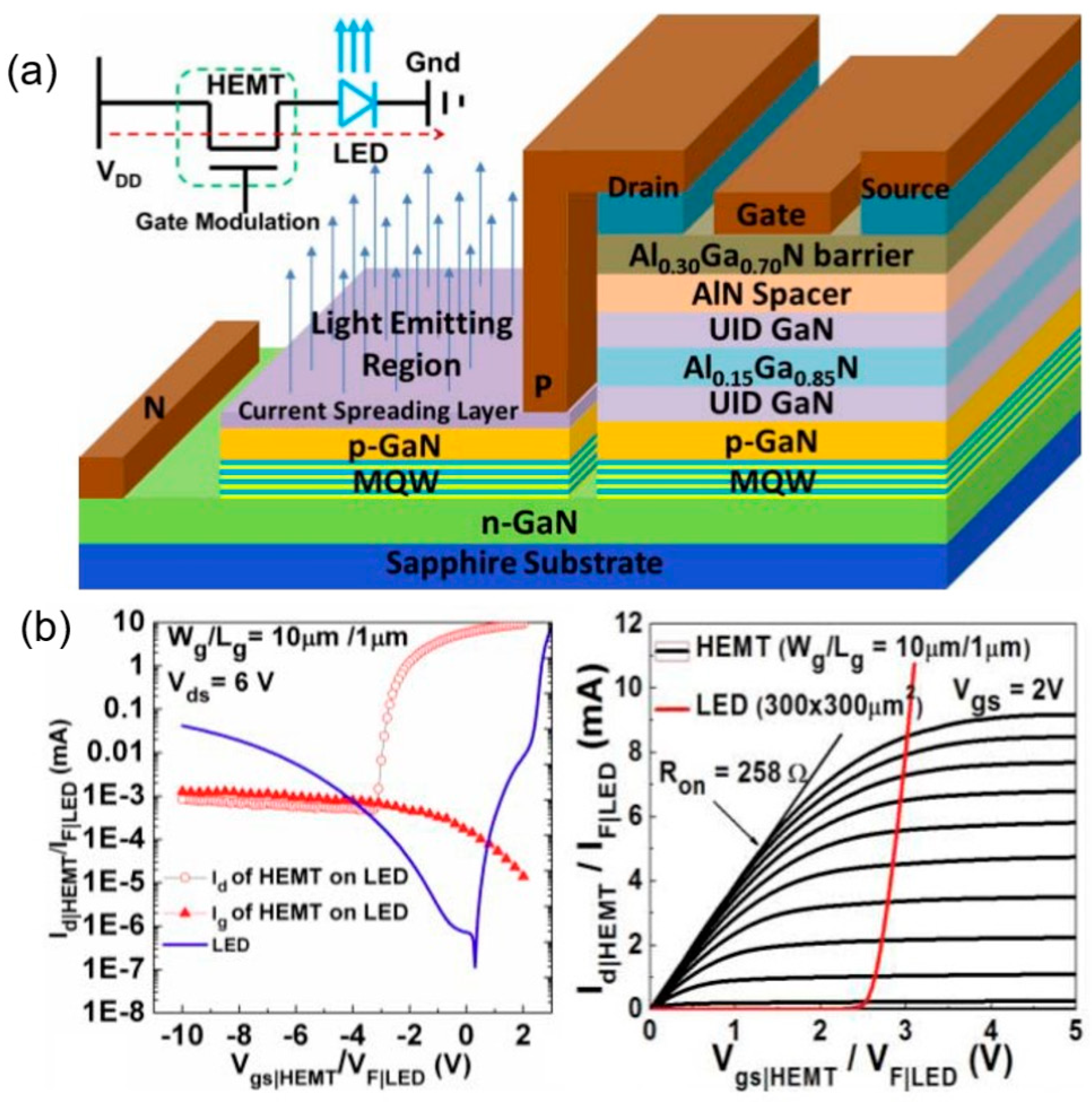

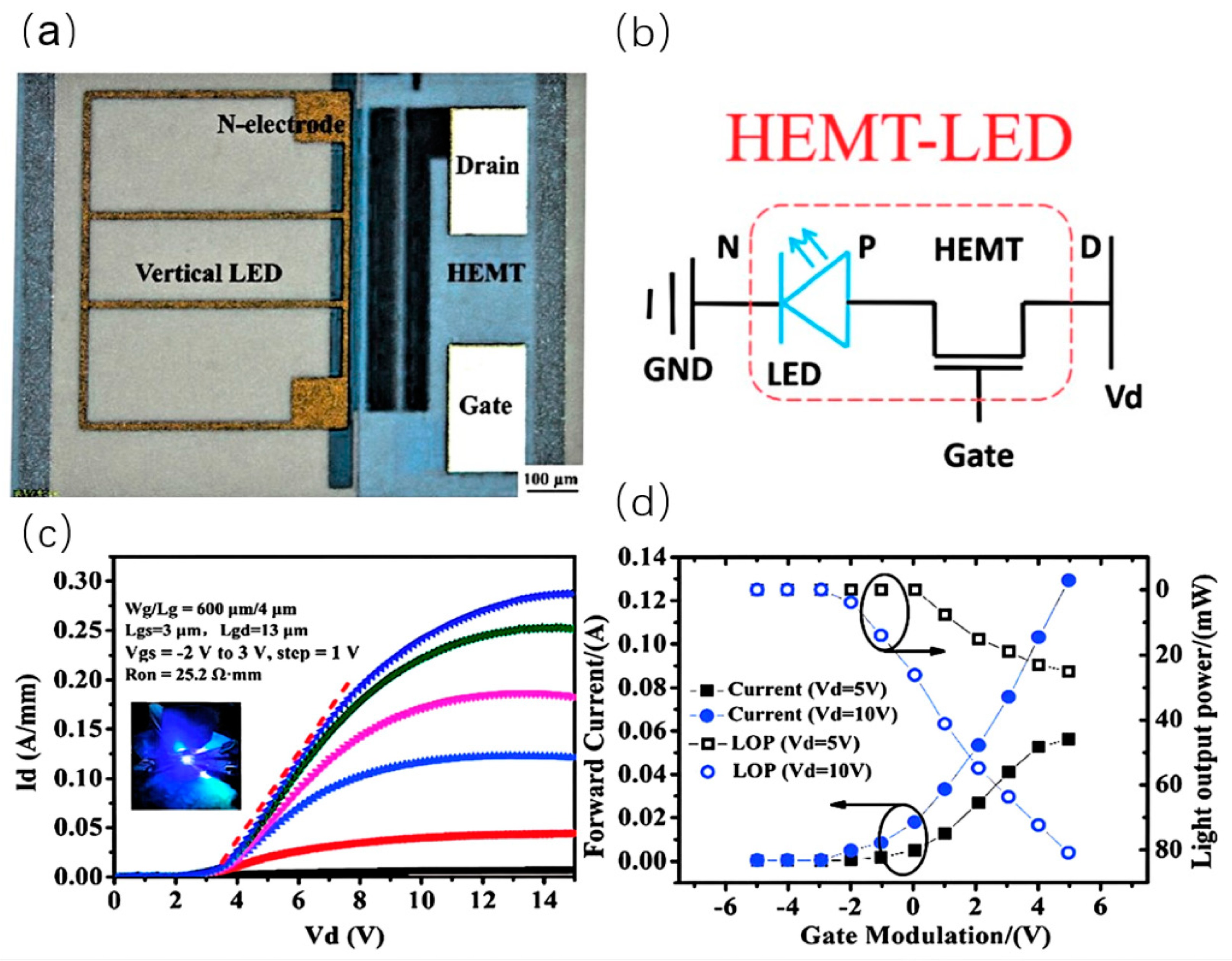
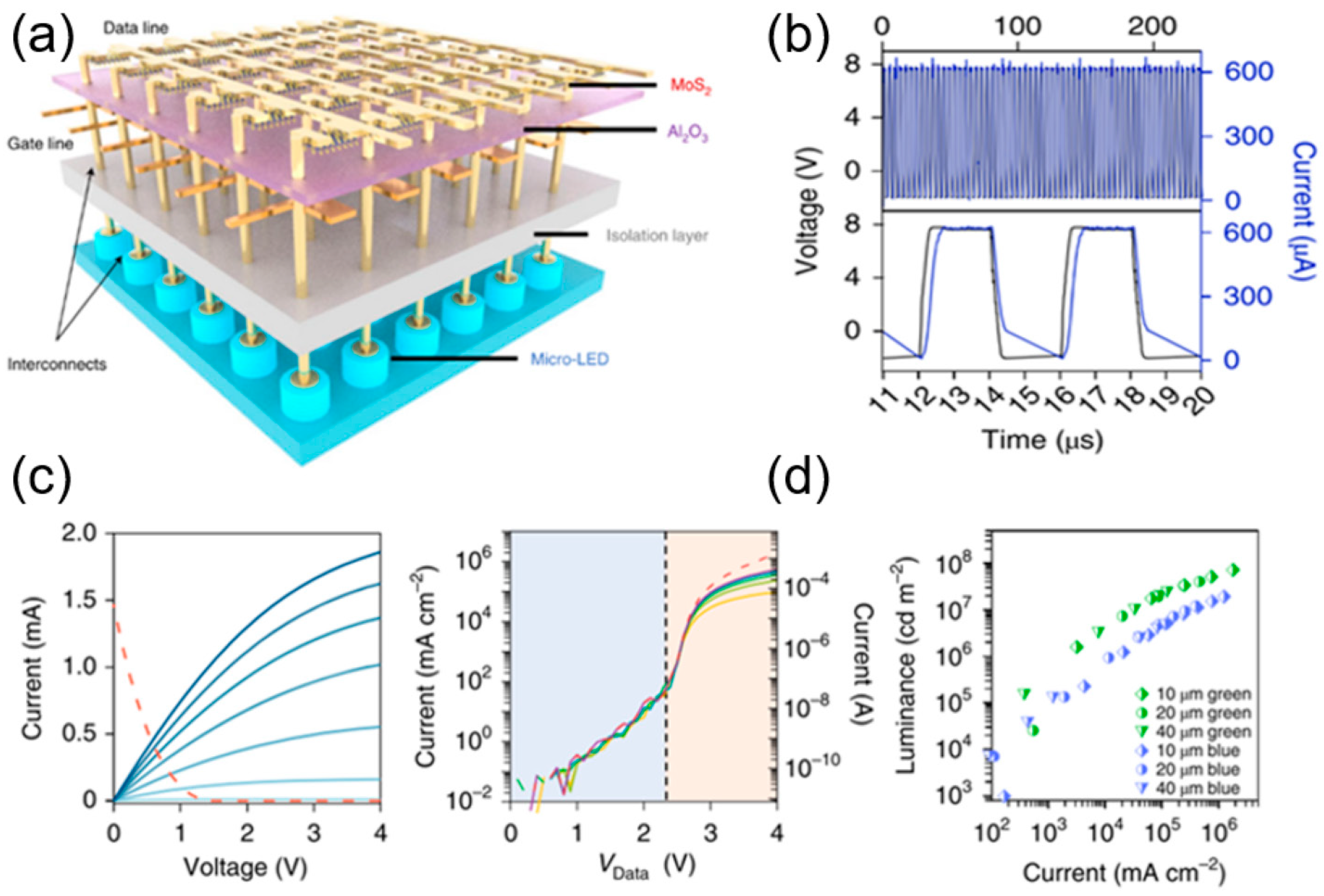
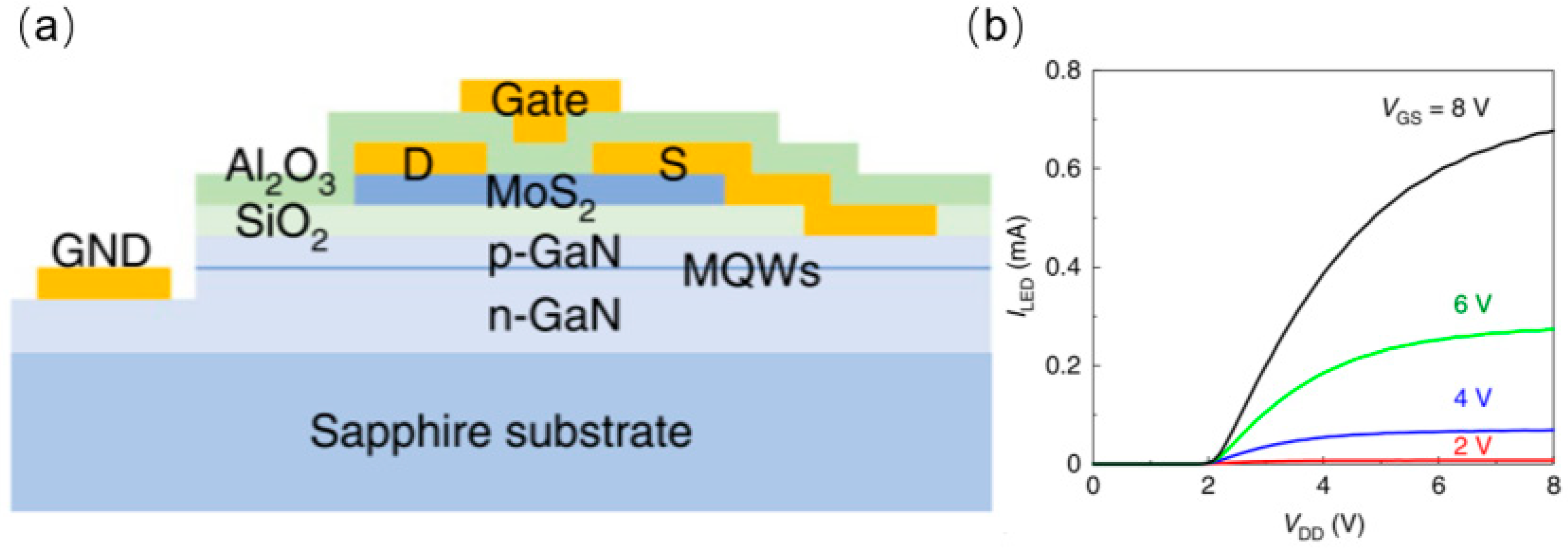
Disclaimer/Publisher’s Note: The statements, opinions and data contained in all publications are solely those of the individual author(s) and contributor(s) and not of MDPI and/or the editor(s). MDPI and/or the editor(s) disclaim responsibility for any injury to people or property resulting from any ideas, methods, instructions or products referred to in the content. |
© 2024 by the authors. Licensee MDPI, Basel, Switzerland. This article is an open access article distributed under the terms and conditions of the Creative Commons Attribution (CC BY) license (https://creativecommons.org/licenses/by/4.0/).
Share and Cite
He, H.; Huang, J.; Tao, T.; Zhi, T.; Zhang, K.; Zhuang, Z.; Yan, Y.; Liu, B. Monolithic Integration of GaN-Based Transistors and Micro-LED. Nanomaterials 2024, 14, 511. https://doi.org/10.3390/nano14060511
He H, Huang J, Tao T, Zhi T, Zhang K, Zhuang Z, Yan Y, Liu B. Monolithic Integration of GaN-Based Transistors and Micro-LED. Nanomaterials. 2024; 14(6):511. https://doi.org/10.3390/nano14060511
Chicago/Turabian StyleHe, Honghui, Jinpeng Huang, Tao Tao, Ting Zhi, Kaixin Zhang, Zhe Zhuang, Yu Yan, and Bin Liu. 2024. "Monolithic Integration of GaN-Based Transistors and Micro-LED" Nanomaterials 14, no. 6: 511. https://doi.org/10.3390/nano14060511




